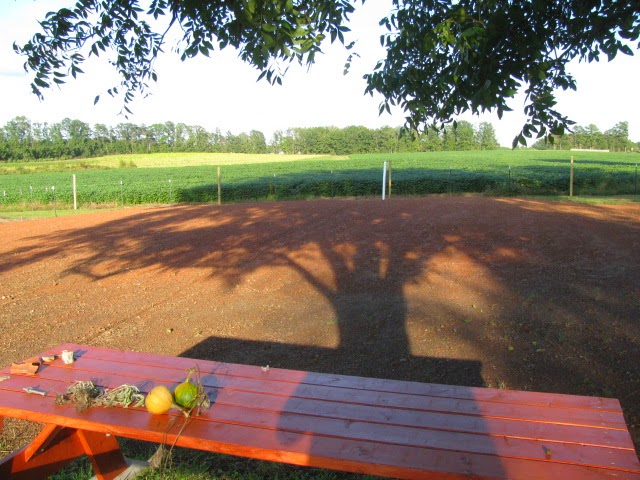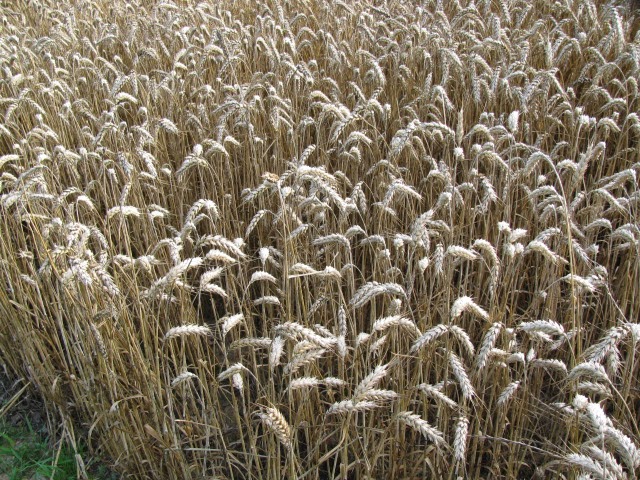Next to the kitchen there is a laundry room <slash> pantry where we store most of our dry good groceries -- flour, bakery ingredients, canned goods, rice , beans, and so forth. Part way through the gardening season and into the canning season we ran out of room. In the dining area we built this wall of shelves to hold all our current and future stock of home canned produce.
Preserves, Hot Sauce, Chiles, Relish, Dill Pickles, Bread & Butter Pickles, Tomatoes, Tomato Sauce, Spaghetti Sauce, Tomatillo Salsa, Baked Beans, Summer Squash, Sun-Dried Tomatoes, Pumpkin, Green Chile Enchilda Sauce, Dried Sage, Marjoram, Oregano, Ancho Chile Powder, Dried Parsley, Dried Cilantro, Cayenne Pepper Flakes. There is room for about 350 jars. I don't think it will be enough next year. We have frozen garden peas, green beans and Basil/Walnut Pesto too.
Thursday, December 4, 2014
The New Lawn (aka Post Septic Tank Apocalypse)
After getting a new septic tank and new septic drain field installed (see earlier post - New Septic System - or How To Spend $600 An Hour) We had to wait for several good soaking rains to settle the ground, then move the soil around from the high spots to the low spots, then wait for more good rainfall and smooth out the ground again. This was no easy task. The area is about the size of a typical suburban lot - about a 1/4 acre. Once we had not waited long enough, but had had enough of looking a red clay dirt we raked the entire area one last time and spread fertilizer and grass seed over the area the day before a rain forecast.
9/26/2014 four days after seeding and a good rain
we have LIFT-OFF!! ..... uh... I mean germination!
10/1/2014 it's starting to look pretty good
10/4/2014 looking like a lawn almost
10/19/14 a thick green lawn!!
Tuesday, December 2, 2014
Halloween Pumpkins
I know, I know..... I haven't posted much on the blog in recent months. Busy, busy, busy. Today is a dreary cold drizzly day - a good day for catching up with blog postings.
This year's pumpkin carving was a minor disaster. Normally the pumpkins I buy for carving keep very well after carving, but this year they didn't. The complicated carving takes a couple of hours or more for each pumpkin so I usually start a few days before Halloween. Normally they still look nice and fresh on Halloween night. I'm sure the very warm day time temperatures for several days before the 31st and the not very cold nights didn't help, but I also think it had something to do with the locally grown pumpkin varieties just not keeping as well as what I'm used to.
So that's my excuse and I'm sticking to it. Here is a photo of the only carved pumpkin worthy of posting. It is, of course, the last pumpkin I carved on Halloween day, so it was fresh and not wilted.
This year's pumpkin carving was a minor disaster. Normally the pumpkins I buy for carving keep very well after carving, but this year they didn't. The complicated carving takes a couple of hours or more for each pumpkin so I usually start a few days before Halloween. Normally they still look nice and fresh on Halloween night. I'm sure the very warm day time temperatures for several days before the 31st and the not very cold nights didn't help, but I also think it had something to do with the locally grown pumpkin varieties just not keeping as well as what I'm used to.
So that's my excuse and I'm sticking to it. Here is a photo of the only carved pumpkin worthy of posting. It is, of course, the last pumpkin I carved on Halloween day, so it was fresh and not wilted.
Harvesting the wheat
OK - we didn't grow the wheat, but we did harvest some wheat this year. The adjoining property to the East has been planted in a rotation of tobacco followed by winter wheat and then by soy beans for many years. When my property was carved out of a larger parcel, a small portion of the crop land ended up on my side of the property line. It was planted in tobacco last spring before I purchased the property and last fall it was planted in wheat. This past summer I cleared the strip where the property line was and started digging post holes for a fence.
So this small corner patch of the wheat field is on my side of the property line.
The ripe wheat is ready to harvest -- I think? How do you know?
There are 2 ways to know when to harvest.
You pluck off a head of wheat from a stalk.......
.....and you rub it briskly between your palms......
....and blow away the chaff and then chew on a wheat kernel to see if it is dry enough.
......or......
you just wait until your neighbor shows up with this behemoth combine to harvest the wheat in the main field right on the other side of the fence. That's when you harvest your little patch.
So we hand cut about a 3rd of the wheat and threshed it by beating bundles of the stalks against the inside of a new, clean galvanized trash can. Then we removed all the chaff by pouring the wheat from a pan in front of a box fan. The wheat chaff blew away into the yard and the clean wheat kernels fell onto a tarp spread on the ground. We got about 40 pounds of wheat kernels that way. We expected the total we would get our patch would be about 100 to 120 lbs, but then we discovered why the wheat had been harvested the day it was. Oh, it was dry and ready to harvest, but more importantly it rained heavily the next day knocking all the remaining standing wheat kernels to the ground. Oh well, it was fun while it lasted.
No I didn't buy a $200, or $400 or $1,000 mill to make $20 worth of flour. We used the wheat as part of a cover crop mix with clover to plant in idle parts of the garden.
Subscribe to:
Comments (Atom)











